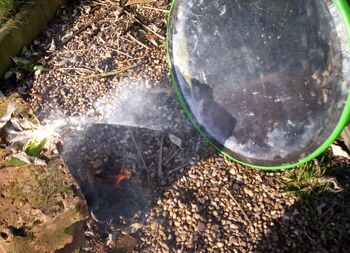Paul Hedrick (talk | contribs) (Created page with '{{Subst:CookerPage}}') |
Tom Sponheim (talk | contribs) mNo edit summary Tag: sourceedit |
||
| (5 intermediate revisions by 2 users not shown) | |||
| Line 1: | Line 1: | ||
| + | {{GoogleTranslateLinks}} |
||
| ⚫ | |||
| + | {{Updated|7|22|10}} |
||
| − | ==External links== |
||
| + | [[File:Rollens_1.jpg|right|350px]] |
||
| + | [[File:Rolens_2.jpg|right|350px]] |
||
| + | [[File:Rollens_3.jpg|right|350px]] |
||
| + | [[File:Rollens_4.jpg|right|350px]] |
||
| + | The '''Rollens''' was created by the late [[Matthew Rollins]] as a teaching tool, to demonstrate the difference in potential performance when varying the focal distance and angle of a [[parabolic]] reflector. He developed a simple way of creating the reflector by fitting the top of a shallow plastic bucket with a mylar film, and then extracting some of the air within the bucket. The resultant air pressure on the film provides the parabolic profile. He has used smoke as a way to display the beam shape during the demonstration. |
||
| + | In his words, "The bucket was moved to different locations to demonstrate the various shapes of the beam from different angles to the target. The beam clearly demonstrates the 'inverse square law'. The energy bounced off the lens can be "tapped" at whatever distance suits the target. This is just as effective either in front or behind the actual focal point. The heat transfer to a can of water was most effective when the beam was spread. A number of experiments were carried out to examine the effects of different coloured target surfaces. |
||
| ⚫ | |||
| + | I also invented a shaped surface designed to capture some of the energy that is lost through secondary emission. The off set angle experiments showed how the mirror loses efficiency as the angles are increased and the aperture that the incoming energy has is reduced. One side benefit of many was that I have the design for a fixed focal point cooker that allows the pot to remain in one fixed spot while a super-lightweight reflector can be tracked round it to follow the sun. An 'inverse polar mount' is what it is." |
||
| + | With some background work provided by Rollins, there may be a new design direction that can be expanded upon, which incorporates a lightweight reflector that can easily change it's postion to the cooking pot for maximum efficiency. |
||
| + | |||
| ⚫ | |||
| + | *[[Matthew Rollins]] |
||
| ⚫ | |||
| + | {{See|Applied Green Technology}} |
||
[[Category:Solar cooker designs]] |
[[Category:Solar cooker designs]] |
||
| − | [[Category:Solar box cooker designs]] |
||
| − | [[Category:Solar panel cooker designs]] |
||
[[Category:Parabolic solar cooker designs]] |
[[Category:Parabolic solar cooker designs]] |
||
Latest revision as of 14:11, 26 August 2015
|
Last edited: 22 July 2010
|
The Rollens was created by the late Matthew Rollins as a teaching tool, to demonstrate the difference in potential performance when varying the focal distance and angle of a parabolic reflector. He developed a simple way of creating the reflector by fitting the top of a shallow plastic bucket with a mylar film, and then extracting some of the air within the bucket. The resultant air pressure on the film provides the parabolic profile. He has used smoke as a way to display the beam shape during the demonstration.
In his words, "The bucket was moved to different locations to demonstrate the various shapes of the beam from different angles to the target. The beam clearly demonstrates the 'inverse square law'. The energy bounced off the lens can be "tapped" at whatever distance suits the target. This is just as effective either in front or behind the actual focal point. The heat transfer to a can of water was most effective when the beam was spread. A number of experiments were carried out to examine the effects of different coloured target surfaces.
I also invented a shaped surface designed to capture some of the energy that is lost through secondary emission. The off set angle experiments showed how the mirror loses efficiency as the angles are increased and the aperture that the incoming energy has is reduced. One side benefit of many was that I have the design for a fixed focal point cooker that allows the pot to remain in one fixed spot while a super-lightweight reflector can be tracked round it to follow the sun. An 'inverse polar mount' is what it is."
With some background work provided by Rollins, there may be a new design direction that can be expanded upon, which incorporates a lightweight reflector that can easily change it's postion to the cooking pot for maximum efficiency.
See also[]
Contact[]
- See Applied Green Technology.Applied Green Technology




